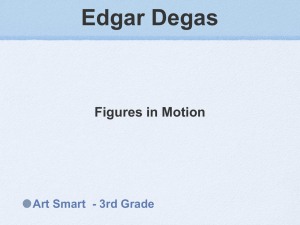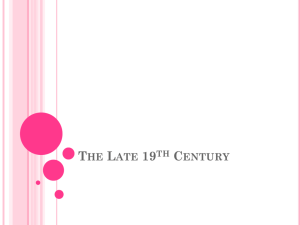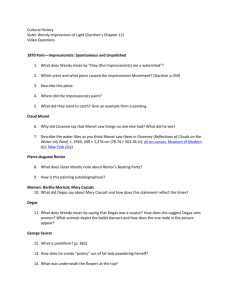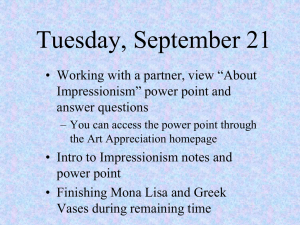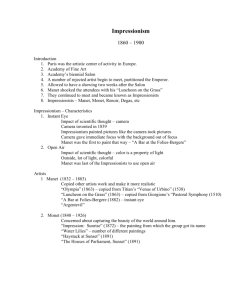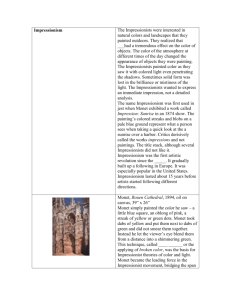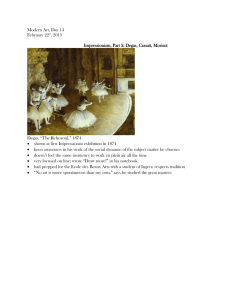MIT 4.602, Modern Art and Mass Culture (HASS-D/CI) Spring 2012 Notes
advertisement
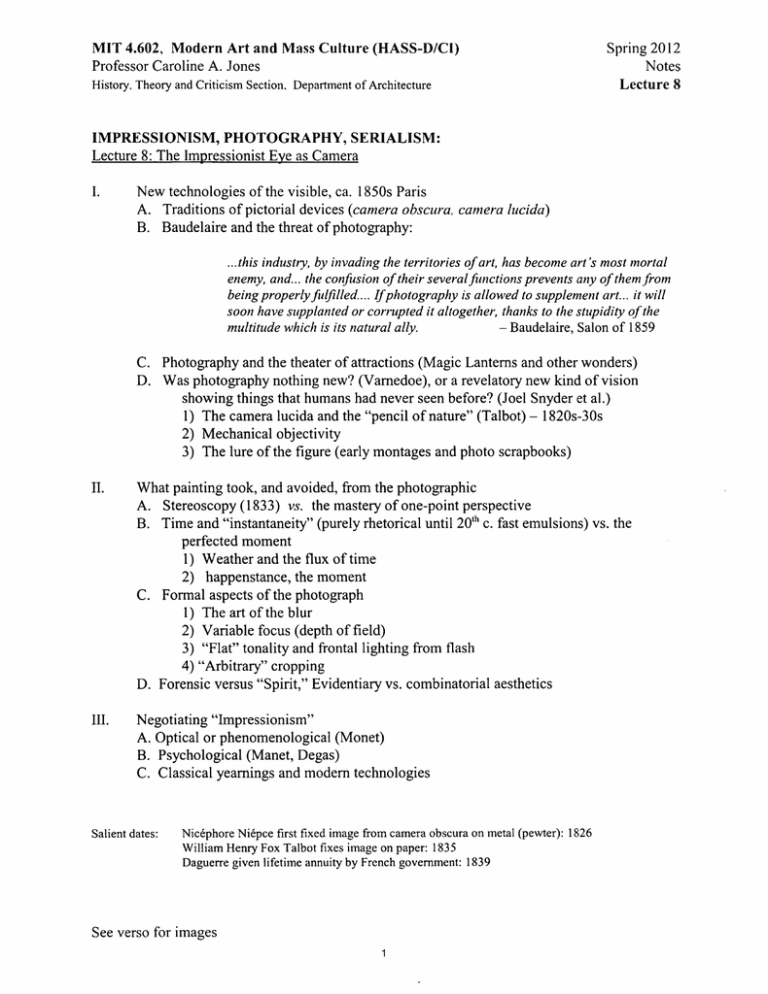
MIT 4.602, Modern Art and Mass Culture (HASS-D/CI) Professor Caroline A. Jones History, Theory and Criticism Section. Department of Architecture Spring 2012 Notes Lecture 8 IMPRESSIONISM, PHOTOGRAPHY, SERlALISM: Lecture 8: The Impressionist Eye as Camera I. New technologies of the visible, ca. l850s Paris A. Traditions of pictorial devices (camera obscllra, camera lucida) B. Baudelaire and the threat of photography: ... this industry, by invading the territories of art, has become art's most mortal enemy, and... the confusion of their several functions prevents any of them from being properly fulfilled. ... Jfphotography is allowed to supplement art... it will soon have supplanted or corrupted it altogether, thanks to the stupidity of the - Baudelaire, Salon of 1859 multitude which is its natural ally. C. Photography and the theater of attractions (Magic Lanterns and other wonders) D. Was photography nothing new? (Varnedoe), or a revelatory new kind of vision showing things that humans had never seen before? (Joel Snyder et al.) 1) The camera lucida and the "pencil of nature" (Talbot) - 1820s-30s 2) Mechanical objectivity 3) The lure of the figure (early montages and photo scrapbooks) II. What painting took, and avoided, from the photographic A. Stereoscopy (1833) vs. the mastery of one-point perspective B. Time and "instantaneity" (purely rhetorical until 20 th c. fast emulsions) vs. the perfected moment 1) Weather and the flux of time 2) happenstance, the moment C. Formal aspects of the photograph 1) The art of the blur 2) Variable focus (depth offield) 3) "Flat" tonality and frontal lighting from flash 4) "Arbitrary" cropping D. Forensic versus "Spirit," Evidentiary vs. combinatorial aesthetics III. Negotiating "Impressionism" A. Optical or phenomenological (Monet) B. Psychological (Manet, Degas) C. Classical yearnings and modem technologies Salient dates: Nicephore Niepce first fixed image from camera obscura on metal (pewter): 1826 William Henry Fox Talbot fixes image on paper: 1835 Daguerre given lifetime annuity by French government: 1839 See verso for images 1 MIT 4.602, Modern Art and Mass Culture (HASS-D/CI) Spring 2012 lInages (selected) for Lecture 8 machine visions Jan Venneer and the question of the camera lucida Magic Lantern slides panoramas, heliographs, and other photo-graphic wonders Eadweard Muybridge, Panorama of San Francisco 1877 Joseph Nicephore Niepce, View from Window at Gras, 1826 (William) Henry Fox Talbot, Latticed Window August 1835 Muybridge, Galloping Horse 1878 Etienne Jules Marey, Walking Man, 1885 * the first Hfixed shadow" the painters, the paintings Frederic Bazille, Summer Scene, 1862 Monet, Boulevard des Capucines, (two versions) 1872 and 1873 Gustave Caillebotte, Rue de Paris. temps de pluie 1877 Edgar Degas, M. & Mme. Edouard Manet, 1868-9 Degas, Place de la Concorde, 1875 Edouard Manet, painting on photograph of The Railway (photograph by J. M. Godet ofManet's painting), 1873-4 Manet, The Balcony 1868-69 Emile Zola, New Version ofManefs Balcony, photograph, undated (19 th c.) Monet, Nympheas, (and detail) 1919-26 Le Gray, Effect of the Sun, Nonnandy, photograph, 1856-59 Degas, Self-Portrait 1857-8 Degas, Young Spartans Exercising, 1860 Degas, Bellelli Family 1858-60 Degas, Au Cafe, L'Absvnthe, 1877 Degas. Woman on a Cafe Terrace. Evening. 1877 Degas. Le Viol (The Rape), 1866-67 Degas, Dans Ie salon d'une Maison Close, 1879 (monotype) Degas, Laundress (four variants) 1869, -74, -86 Degas, Dance School, 1873 Degas, Aux Ambassadeurs (a cafe) 1877 Monet, Dejeuner sur l'herbe, 1865-6 (and studies) Monet, Lady in the Garden, 1867 Monet, Impression, Sunrise 1872-3 (gave the movement its name) Monet, Waterlilies/Nympheas. 1905-1907 (through the end of his life) 2 MIT OpenCourseWare http://ocw.mit.edu 4.602 Modern Art and Mass Culture Spring 2012 For information about citing these materials or our Terms of Use, visit: http://ocw.mit.edu/terms.
